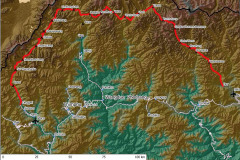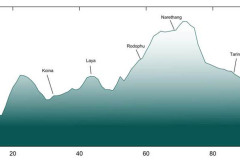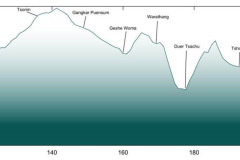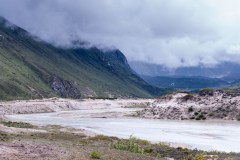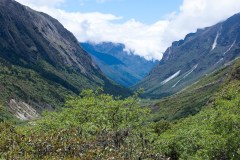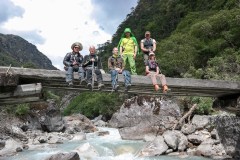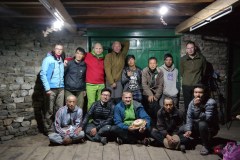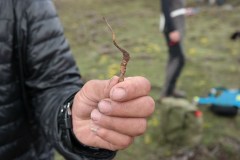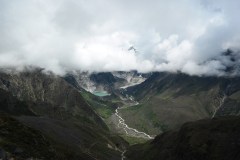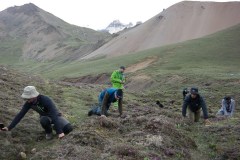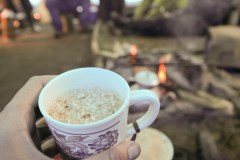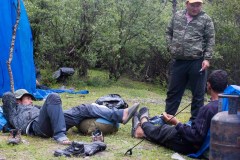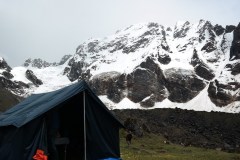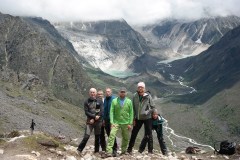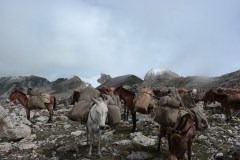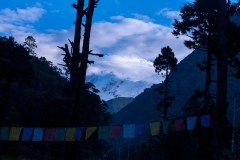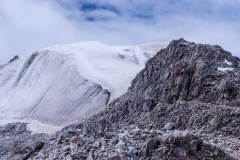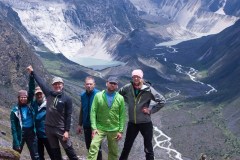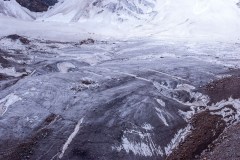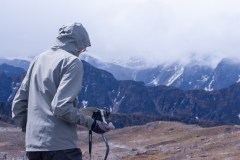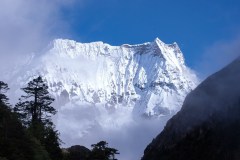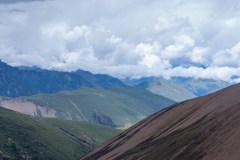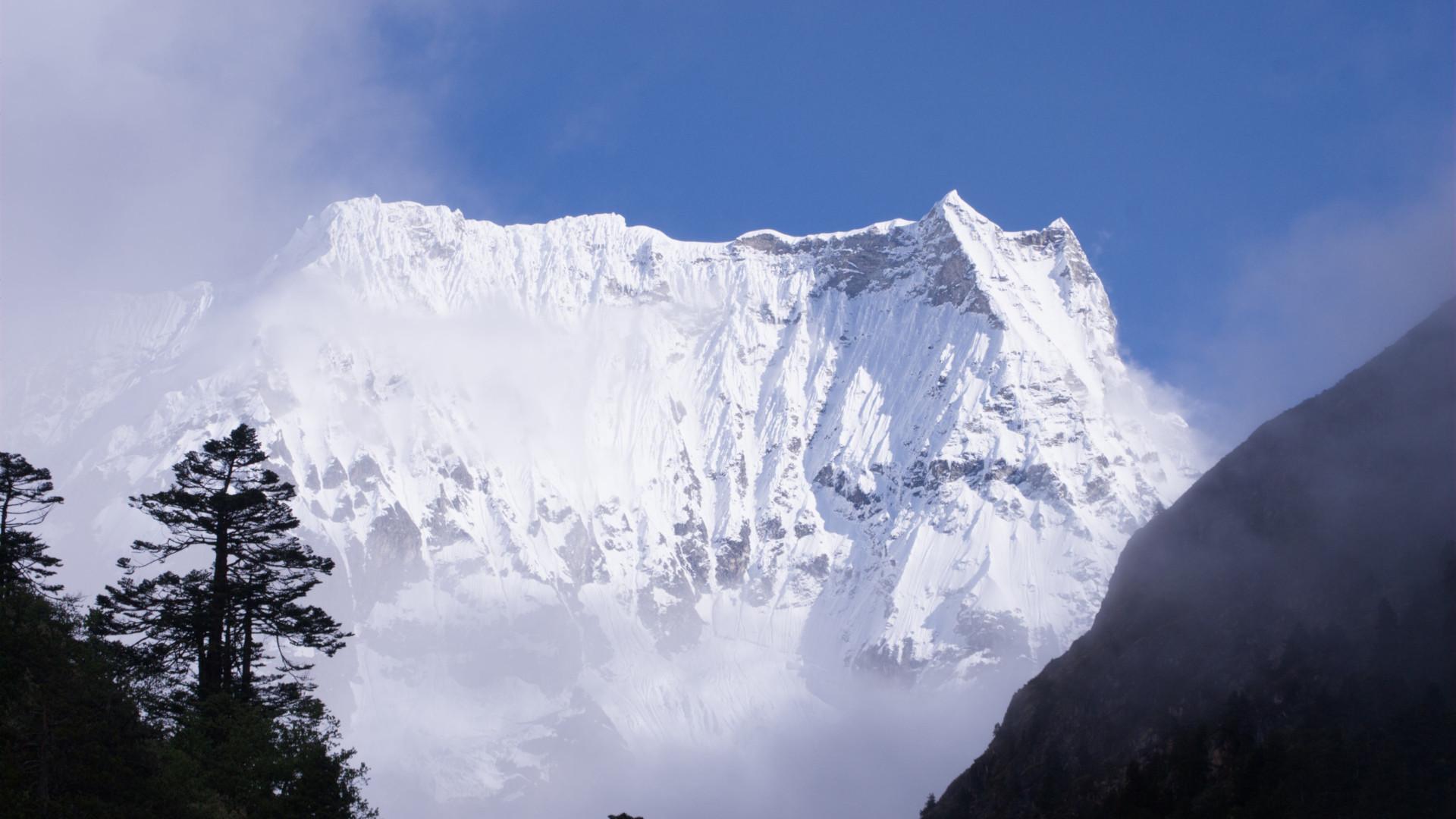
If you have one month to set aside, legs of steel, and complete determinism, you can complete the 340km Snowman Trek in Bhutan.
The Snowman Trek has been labelled as the most difficult trek in the world by Lonely Planet. While no technical climbing skills are required, the difficulty comes just from the combination of duration and the many high-altitude passes that must be crossed along the way.
The most common route of the Snowman Trek starts north of Paro at Drugyel Dzong and finishes near Bumthang in a village called Dur. There are actually several places along the way where there are alternative paths that can be taken if the path is blocked with snow. There is a variant of the trek which is often called “Half-Snowman” that starts at Gasa but still requires about 19 days through the remotest parts of Bhutan.
Snowman Trek Virtual Tour
If you are curious to get an idea about what you would see on the snowman trek, you can watch my 7-minute virtual snowman trek tour. I created this using Google Earth with a relatively high eye elevation but the scenery that you see in my video is relatively close to what you would experience. Unfortunately, the elevations of the passes are from the non-corrected GPS readings so you might have to add between 50 and 150 meters to the values that are shown in my movie.
The Cost of the Snowman Trek
Unfortunately, besides being the hardest and longest trek in Bhutan, it also turns out to be the most expensive. The reason for the price partially is based on the number of days that you must be in Bhutan (remember that each day has an SDF fee that must be paid) and the price is influenced by the remoteness of the trek.
The guide charges more money in these remote parts simply because they have the experience on the route and their local knowledge is critical when it comes to difficult situations. Running a trek for 31 days is full of logistical problems just to deal with the food. A typical snowman trek uses between 12 and 20 horses to carry some 150kg to 250kg of food for the trekkers plus the support staff, the LPG cylinders for cooking, the tents, and any other equipment that is required to be used along the trek.
There are no actual places along the trip where food can be purchased. The pony team is loaded up with food at Drugyel Dzong with enough to make it Laya. Although Laya is a fairly large village along the way, there are no places where sufficient food could be purchased to make the second part of the trip. Therefore a trekking team with a replenishment of food must be carried up from Gasa (another team of horses making a 2 day trek) to deliver the food just as you reach.
Even when you finish the trek, the trek expenses are not actually finished. You get picked up and moved to a hotel and eventually moved back to Thimphu or Paro by car or flight. Remember that there are now some 20 horses in central Bhutan that actually belong back at Paro and somebody has to move them back.
If you look at the pricing tabe, you will probably be shocked by the cost of a small group. This is because organizing the trip for one person is no less difficult than for 10 people. As the size of the group increases, we are able to offer much better prices just because of the economy of scale.
Are you only one person and want to try to travel in a group? Please let us know, we maintain a mailing list of people who have contacted us. Sometimes the list doesn’t get big enough to drop our price but there is no cost in asking.
Route Map and Elevation Profile
The highest point along the path is Gophu La Pass at 5230m. If you do some Google searching online, you will find that some people claim Gophu La Pass at 5455m and sometimes 5230m. So why the confusion?
The problem with the altitude measurements is that most of the measurements were done using various GPS devices at various times. Although a GPS with 10-12 satellites might claim that it is within 3-5 meters accurate, the altitude measurement tends to be highly inaccurate. The earth is not round, no this is not some flat earth type lecture, but it is an ellipsoid (think of a watermelon type shape). The coordinate system WGS84 used by most GPS units and even Google Earth is quite accurate for position but the altitude you’re your GPS is likely based on the ellipsoid approximation that doesn’t actually match reality.
For example, where I am sitting in Thimphu writing this page, my GPS gives an elevation of 2188m but Google Earth gives my elevation at 2359m. This sounds like the GPS must be completely unreliable but the Long/Lat position from the unit shows pretty close to my real position on Google Earth. My GPS unit is relatively old (about 2006) and doesn’t contain any sort of correction for the altitude. A newer GPS system like the one on my iPhone is likely to use corrections and gives the elevation of 2350m.
In the video that I produced for the virtual snowman trek, I used the old uncorrected GPS coordinates but in the descriptions below I’ve try to be a bit more accurate to match what is being shown on Google Earth.
Time of Year
The route is at a high enough elevation that snow can be present at most times of the year. The snow usually stops falling in March, but the passes can still remain blocked for a couple of months. The snow begins again in mid-October, so within a couple of weeks you can expect the path to be impassable once again.
Weather is completely unpredictable and so there is a risk that no matter when you go, you may have to abandon the trek. There are times however where you changes are pretty much 100% and these are when you reach Thanza between mid-June and mid-October.
The trips in June have a higher chance that you will have to endure rain and the skies are likely to be cloudy while a trip in October will likely have no rain, but the temperatures are going to end up being much colder.
Health & Safety
Communication in the Lunana region is quite limited. Between Paro and Laya there is generally mobile coverage available but from Nerathang to Bumthang there is hardly any mobile phone service. We provide the guide with a satellite phone in case of emergency and even then, it is sometimes necessary to send somebody with the phone to a position where the satellite is not blocked by a mountain.
Reading about high altitude trekking, you might find some descriptions of a device called a Gamow Bag; a mini hyperbaric chamber in which somebody suffering some altitude sickness can get inside and the bag can be inflated so that the altitude pressure is lower. The actual ascent made by the trekkers starting in Drugyel Dzong is a slow steady climb and with the extra day at Jangothang, trekkers can easily acclimatize. It is not likely that a trekker is going to suffer altitude sickness later on in the journey that would require the use of a Gamow bag because they are unlikely to move forward fast enough. Our team does carry cylinders of oxygen in case there are problems. Most parts of the trek easily allow for the descent to a lower altitude and there is always the option of a helicopter evacuation should something very serious arise.
Altitude Acclimatization
The snowman trek takes you as high as 5455m (17896 ft) at Gophu La pass which is a serious altitude when it comes to considering altitude sickness. The good news is that you only reach Gophu La pass after 19 days on the trek and the altitude increase is rather gradual so your body will have become acclimatized well before this point.
To acclimatize to the lower oxygen levels at high altitude you need to increase your altitude at a slow rate. Luckily the start of the snowman trek slowly increases the elevation from 2500m at Drugyel Dzong to 4000m at Jangothang over a period of three days. The rest day at Jangothang is not there because you are expected to be tired after only 3 days but rather so that you can use the day to climb as high as 4900m returning back to the camp for sleeping. This practice, knowm as “trek high, sleep low” is an important part of the acclimatization process. Even the day after the halt at Jangothang, the trip takes you over Nyila La Pass at 4870m but returns you to 4000m for the overnight.
Power
We all have lots of gadgets that we carry with us during travel such as cameras, mobile, phones, GPS units, etc. While travelling about in various hotels, we always have the ability to charge up the devices at night. During the snowman trek, you won’t be finding very many places with power. The first few stops sometimes has power but beyond Chebisa until Laya there is nothing. After Laya, you should be prepared for no power until reaching the end of the trek! Sometimes the school in Lhedi or Thanza may allow you to charge your batteries from their solar setup but if the sun has been limited, they might not be willing to depart with the energy they have collected.
This means that you should bring sufficient batteries or power banks to make it through 14 days. In order to make your camera batteries last try these tips:
- Turn off your LCD display (if possible). If not, turn down the brightness to as low as it can go and minimize the amount of time that it is on. This is the one trip where a standard DLSR is going to win over a mirrorless or point and shoot camera.
- Don’t preview your images after taking them.
- Turn off any sort of option like wireless, Bluetooth and sensor cleaning.
- Turn the camera complete off when not in use.
- Minimize the amount of “powered zoom” that you use. This means if you have a point and shoot camera where the zoom is done with a button, don’t use the zoom feature so much. If you have a manual zoom, the this doesn’t really matter.
- Minimize the use of focusing. Each focus attempt will use power so if you have a DLSR you can switch to manual focus each shot.
- Disable image stabilization when not necessary. If you need stabilization consider taking a lightweight tripod or use a rock to stabilize the camera.
- Before heading out on the snowman trek, why not buy a couple of new batteries. Batteries tend to get weak over time and do not hold a charge as much as new ones. I also recommend not taking the approach of picking cheap no-name batteries (or if you do buy about 3 times the number). Most of the cheap non-name batteries I’ve purchased for the Canon DLSR have had limited capacity compared to an original Canon.
Time Required to Plan
How much planning in advance do we need to book the trip? The answer probably depends on how busy our trekking guide is. It might be possible to book the trip with less than 1 month notice but it would be far better to plan 6 months in advance. This way we can make sure that everything is ready and if you want to use the flight to return from the East, there is a chance that the seats will be available.
Plane or Drive Return to Western Bhutan
At the end of the snowman trek, you will find yourself in central Bhutan in a small town called Bumthang. The drive from Bumthang to Thimphu is about 9 hours if there are no roadblocks due to landslides from heavy rain. The road is mostly good except for a 1-hour section near Trongsa where the road is still not blacktopped (as of July 2019). If you are finishing the snowman trek in September to November, then there is relatively low chance that there will be road blocks and the drive back will be relatively easy. However, if your trek is finishing in July or August, be prepared for a very long and muddy trip back by road. It is actually much easier to fly back to Paro during the summer months but even then we have seen flights cancelled due to low clouds.
Program
-
Day 1
Paro
The flight to Paro offers a breathtaking view of the mighty Himalayas. On your arrival at Paro International Airport, complete your visa formalities and you will be received by your representative, who will accompany you for the tour of Paro.
-
Day 2
Paro
We will do an acclimatisation hike to Taktsang Monastery, which will be about 3 hours of moderate difficulty. Lunch will be served at the cafeteria. The cafeteria is a beautiful viewpoint from which the Taktsang Monastery is visible. Hike further to the Monastery. After a tour of the Monastery, hike downhill, where the vehicle will be waiting to transfer to the hotel. On the way, stop by the Kyichu Monastery.
-
Day 3
Soi Thangthangka
Drive to Gunitsawa and walk along the river valley, which gradually becomes narrower and closes in after some distance. The winding trail with frequent climbs and descents leads us to our campsite in a meadow in tents at 3,600 m. By then, we will have trekked about 23km in 7 to 8 hours.
-
Day 4
Jangothang
The trek follows a gradual uphill trail that passes an army outpost. Pack lunch on the way. After lunch, you will be passing through the bases of many snow-peaked slopes. Overnight in camp at the base of Mt. Jomolhari.
-
Day 5
Jangothang
To help with altitude acclimatisation, a day of rest is planned here. Taking many side trips from the camp can help acclimate your body to the altitude.
-
Day 6
Lingshi
Distance: 17 km. Trek time: 6–7 hours. Altitude of camp: 4150m.
Trek through vast yak pastures and beautiful snow-clad mountains. Today, you will be crossing the Nyile La pass at 4,890 m. As you approach the Lingshi basin, the breathtaking view of the Lingshi Dzong can be seen. The Tserimgang mountain and its glaciers rise at the north end of the valley, and camp near the stone shelter for travellers. -
Day 7
Chebisa
Distance: 12 km. Trek time: 4-5hours. Altitude of camp: 3850m.
This is probably the easiest walking day of your trip, and the walk is on a wide trail with hardly any ascents. On reaching camp, one can visit the small yak herding village or take a walk to the upper end of the valley. -
Day 8
Shakshepasa
Distance: 17 km. Trek time: 6–7 hours. Altitude of camp : 4260m.
The trek today is through wild high pastures, and the trail passes through a few sparsely populated villages. You will be crossing the Gokula Pass at an altitude of 4,440 m. -
Day 9
Robluthang
Distance: 22 km. Trek time: 7-8 hours. Altitude of camp: 4320m.
An early start is advisable as you will be crossing the Jarila Pass which stands at 4785 m above sea. Then descend down to Tsarijathang where herds of the National Animal, Takin can be seen. Camp on the flat ledge above the river. -
Day 10
Lingmethang
Distance: 14 km. Trek time: 6–7 hours. Altitude of camp: 4160m.
Today is the first extremely high altitude pass of Sinche La, which reaches 5000m. -
Day 11
Laya
Distance:10 km. Trek time: 4 -5 hours. Altitude of camp: 3804m.
One of the shortest trekking days of the entire trip. -
Day 12
Laya Halt
Today, you will explore the village and meet people. Layaps, or the people of Laya, are welcoming and will readily pose for photographs if you aspire to have one. Their dress is very typical, and particularly of women, who often wear bamboo hats decorated with turquoise and silver ornaments, making them more special. In the evening, you’ll have the opportunity to be part of a cultural event featuring local girls performing dances.
-
Day 13
Rodophu
19kms, approx. 6-8 hours, 1,030m ascent, 750m descent, camp altitude 4160m.
We continue following the river till the turn-off point to Rodhuphu. After lunch, we pass through lush rhododendrons till we reach the camp at a height of 4 350m. By then, we will have trekked for about 8 to 9 hours.
-
Day 14
Narithang
Distance 17 kms, 6-6 hours, 750m ascent, camp altitude 4900m
The trail leads most of the time up hills through dense rhododendron bushes and barren areas with lots of ups and downs. We cross TSHOMO LA (4780m) and descend to the campsite at Narithang (4500m). Yak herders are often seen camping in this area during the summer.
-
Day 15
Tarina
Distance 18km, 5-6 hours, 270m ascent, 1200m descent, camp altitude 3970m
We start as early as today, it’s the long stretch that we have to trek. We climb to Karchung La at 5150m and conquer the summit from where one can have a splendid view of Tari Gang at 7300m. Karchung La or Gangla Karchung is the point where the two main rivers converge. The front part of the pass is the starting point of the Mo Chu (female) river at Punakha, and the back side is the place where the Pho Chu (male) river begins. The trails are not as easy as we think.
-
Day 16
Woche
Distance 17kms, 6-7 hours, 270m ascent, 330m descent, camp altitude 3910m
We trek downhill, taking us through the coniferous forest following the upper ridges of the Phochhu. Then, the trail climbs over a ridge and drops to Woche at an elevation of 3,800 m. After 6 to 7 hours of walking, camp here for the night.
-
Day 17
Ledhi
Distance 17kms, 6-7 hours, 980m ascent, 1190m descent, camp altitude 3700m
The trek begins through juniper and fir forests, gradually transitioning into rhododendron forests. Climb up to Keche La Pass at 4480m where one can have a great view of surrounding mountains. After the Pass, descend to the riverside, walking through the village and enjoying the scenic view of the mountains that roof the valley. Follow the river that leads up to Lhedi Village, where one of the primary sources of Phochhu originates. Camp at an altitude of 3, 650m
-
Day 18
Thanza
Distance 17kms, 7-8 hours, 450m ascent, camp altitude 4,150m
The trek continues along the riverbank, gradually ascending to Choejung Village. Cross the bridge and after 7 to 8 hours of trek, we reach Thanza at 4,000 m, where we camp.
-
Day 19
Thanza Rest day
We take a rest for a day by exploring nearby lakes and mountains. It will provide a refreshing break to rejuvenate you for the rest of the trek.
-
Day 20
Tsorim
The trek begins by climbing a ridge offering a stunning view of Table Mountain and Thana’s Valley below. The ridge altitude is 4,500m, and it rises gradually up to 4,650m. After lunch, walk upwards towards the left side of the bridge to enjoy the view of snow-capped mountains. You reach the campsite of Tshorim after climbing more ridges.
-
Day 21
Zanam La
(6-7 hours, camp altitude 4,970m).
This is one of the highlights of the trek, and the day starts with a short climb to the Tshorim Thso. You walk on the side of the lake, enjoying a panoramic view of the Gophu La ranges. The last climb to the Gophu La pass (5,230m) is very short. After the pass, descend to the base camp, walking along the ridge to enjoy a great view of Gangkhar Puensum. If interested, you can divert to the left side to climb up the pyramid peak for a better view, or you can go down to the nearby base camp of Sha Chhu.
-
Day 22
MenchuGang la
-
Day 23
Warathang
The path continues following Sha Chhu for two and a half hours until the stiff climb to Saka La begins. Visibility along the Saka La trail is poor so one must see top of the ridge for guidance. After having lunch nearby a yak herders’ camp you climb up to Saka La (4,800m). The path then descends to a couple of lakes and another short ascent is stunning. Scenery once again is beautiful with small lakes and the mountain peaks.
-
Day 24
Dur Tsachu
(5 hrs, camp altitude 3,590m)
An hour climb leads to Juley La (4,700m). After the pass, you descend to the riverside through dense rhododendron, juniper and conifer forests. After the bridge, a short climb leads to Duer Tsachu. These hot springs, where Guru Padmasambhava is supposed to have taken a bath, might be the most stunningly beautiful hot springs of the Himalayas. You might want to spend an extra day at Duer Tsachu.
-
Day 25
Tshochenchen
(8-9 hours, camp altitude 3,850m).
From the hot springs it is a long and steady climb again with great views of mountains in Lunana. You will also come across blue lakes and yak herder huts.
-
Day 26
Bumthang
This is the last day of the trek, and your porter changes from yaks to horses. The path follows the Chamkhar Chhu, descending gradually with a few climbs interspersed along the way. The trek ends here when you arrive at Duer village. From here, you drive to Jakar (Bumthang).
-
Day 27
Bumthang
This morning, we will do some short sightseeing. Drive to Tang to visit the Oygyen Choling Musuem, and visit the Mebar Tsho.
-
Day 28
Drive to Punakha
After breakfast, drive to Punakha which is about 6 hours journey.
-
Day 29
Drive to Thimphu, via Punakha
In the morning, visit Punakha Dzong, walk on the suspension bridge, and visit Chimi Lhakhang. After lunch, drive to Thimphu. Free evening.
-
Day 30
Thimphu
After breakfast, we will drive the Mini Zoo to see the country’s most endangered animal – the Takin. It’s a goat antelope found only in this part of the Himalayas and one of the planet’s most vulnerable creatures. We will then visit the Painting school (school of 13 traditional arts and crafts). We will also visit the Royal Textile Museum and Royal Bhutan Post. After lunch, visit Memorial Chorten and drive to Kuenselphodrang to view the world’s tallest sitting statue of Shakyamuni Buddha, overlooking Thimphu valley. In the evening, visit Trashichho Dzong, the throne room of the King, various government organization and the office of the central monastic bodies.
-
Day 31
Departure
Drive to the airport, where our guide will see you off for your next destination.
Prices shown are for 3 star hotels. A custom trip with 4- or 5- hotels can be arranged in the cities but only basic accommodation in home stays are available during the trek.
| Group Size | Price/Person (USD) |
| 2 | 12,500 |
| 4 | 10,000 |
| 6 | 9,100 |
| 8 | 7,400 |
| 10 | 7,300 |
Guests wishing to stay in a single room will incur a single supplement charge of $335.
Included
- Visa fee and SDF
- Hotel accommodation on twin sharing basis
- Full board meal plan with Breakfast, Lunch & Dinner
- Registered English speaking Guide
- Comfortable luxury private vehicle (according to group size)
- Complimentary water
- Entrance fees to parks, monuments, and monasteries listed on itinerary
Excluded
- Airline Tickets
- Table drinks and alcoholic beverages
- Any expenses arising out emergency situation
- Tips to guides and drivers
- Any other expenses not mentioned in the included section


